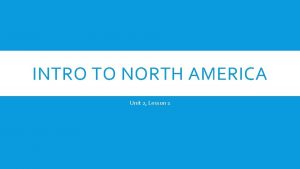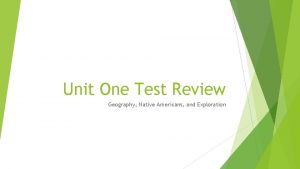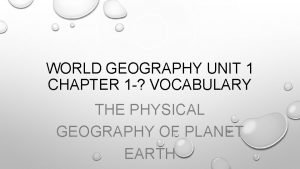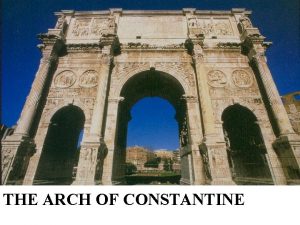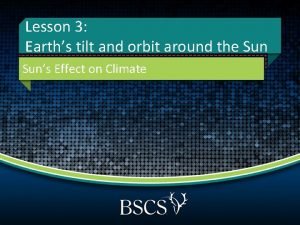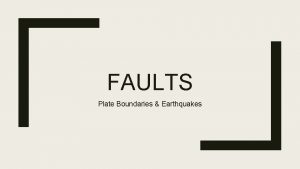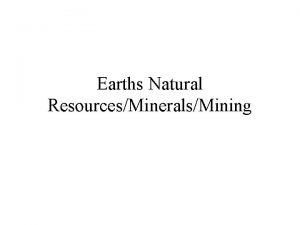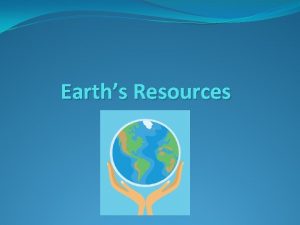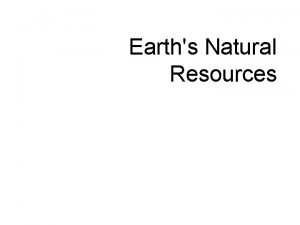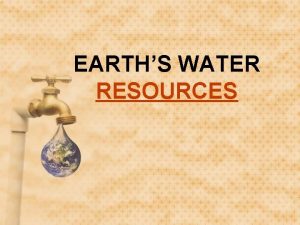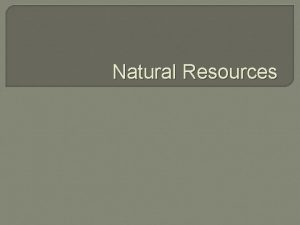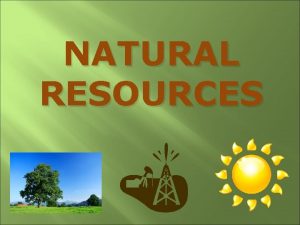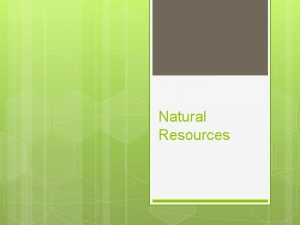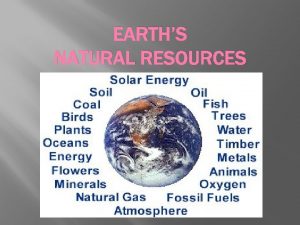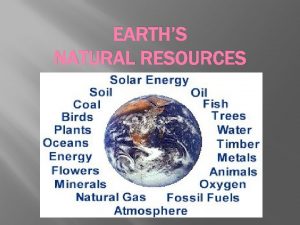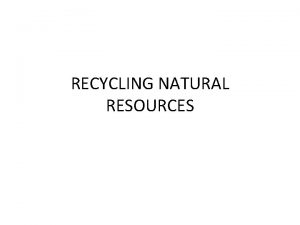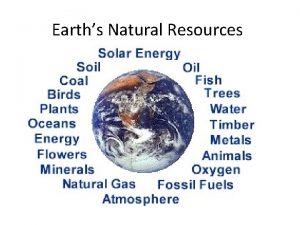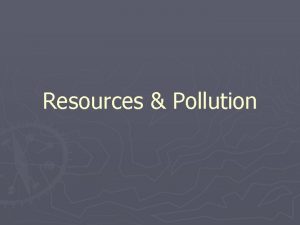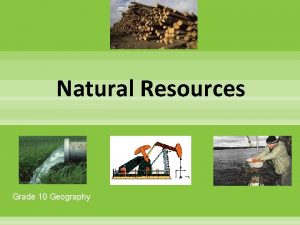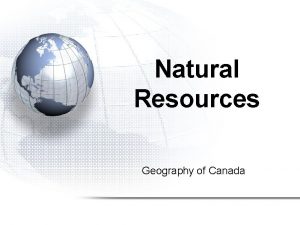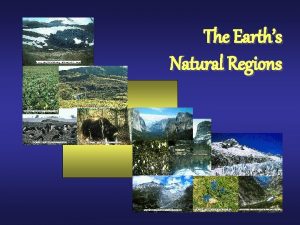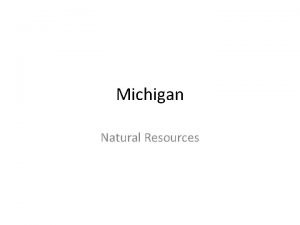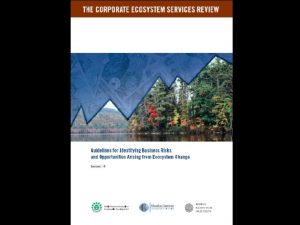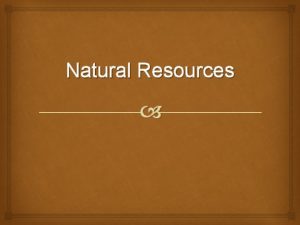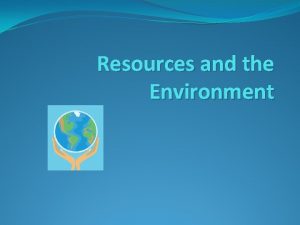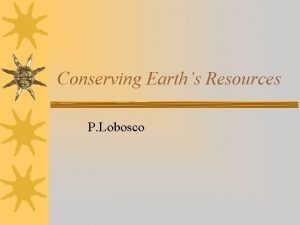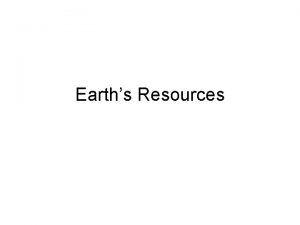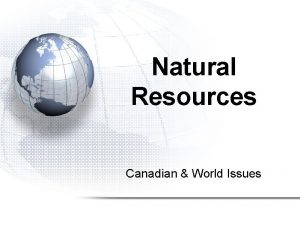Earths Natural Resources Unit 4 World Geography What




























- Slides: 28

Earth's Natural Resources Unit 4 World Geography

What Are Natural Resources? l natural resource- any useful material found in the environment l raw material- a resource or material that is still in its natural state, before being processed or manufactured into a useful product l recyclable resource- a resource that cycles through natural processes in the environment (water, nitrogen, carbon) l renewable resource- a natural resource that the environment continues to supply or replace as it is used (trees, water) l nonrenewable resource- a resource that cannot be replaced once it is used; they include fossil fuels such as coal and oil, and minerals such as iron, copper, and gold l fossil fuel- any one of several nonrenewable resources created from the remains of plants and animals

l __________________________________ _________________. ¡Example: Trees are the raw materials for paper and wood. l A natural resource is anything from the Earth that helps meet people’s needs for food, clothing, and shelter. ¡Examples: ______________

Three Kinds of Resources Recyclable Renewable Nonrenewable __________________ __________________ __________________. Examples: water, nitrogen, carbon Includes trees and other living things: They can be destroyed or wiped out. However, these resources can be replaced, if careful, to maintain a steady supply. __________________ _________. Most nonliving things are nonrenewable. Examples: minerals, coal, natural gas, petroleum (oil), metals Examples: trees, chickens, corn

Ancient Energy: Fossil Fuel l ______________________________________. l Fossil fuels include coal, natural gas, and petroleum. l Fossil fuels were created over millions of years from the remains of prehistoric plants and animals. l Fossil fuels are no longer being created. As a result, they are nonrenewable resources. l ______________________________________.

A Special Resource: Energy l Everyone in the world needs energy, but energy resources are not evenly spread around the world. l If a country does not have enough energy resources of its own, it must buy them from other countries. l __________________________________ _________________.

l In the 1970 s, the United States used so much energy that it had to begin buying oil from OPEC (the Organization of Petroleum Exporting Countries). l ______________________________________. l When OPEC limited supplies and raised prices, the United States experienced oil shortages. l ______________________________________.

Top Petroleum Consumers and Producers United States 12. 1% 11. 5% Saudi Arabia Russia 8. 5% Iran 4. 9% Mexico 4. 5% China 4. 3% Norway Venezuela United Kingdom Canada 4. 2% 4. 1% 4. 0% 3. 5%

Stages of Resource Development First Level Second Level Third Level People use land resources directly to make products. __________________ _________. Examples: hunting, fishing, mining, herding, farming __________________ _________. Example: A farmer takes his corn to a mill. The miller grinds corn into corn meal, and the miller sells the corn meal for more processing. Products are distributed to people who want them. People are producing a service. Examples: __________________ __________________.

Economic Patterns: Developed and Developing Countries l ______________________________________ ___________________. l This change in the way people made goods was called the Industrial Revolution. The Industrial Revolution created a new pattern of economic activity. It separated countries into two groups l Developed Nations are those countries that have many industries l Developing Nations are those countries that have few industries.

Industrial Societies Developed Nations: A Fact Sheet l About one quarter of the world’s population lives in developed nations. l They use goods made in factories. l Their industries consume a lot of raw materials and use power-driven machinery. l ___________________________________________. l Most people live in towns and cities and work in business and industry.

Industrial Societies Developed Nations: A Fact Sheet l ___________________________________________. l They rely on commercial farming, which raises tremendous amounts of food. l ___________________________________________. l Each part of the economy relies on the other. l Problems: unemployment, pollution, shortages of natural resources

Developing Nations l Every culture is not like the United States. Most of the people of the world (about 75%) live in developing countries. l They do not have great wealth. l Many work at subsistence farming—raising just enough food for their families or communities, not for profit. l These farms require a lot of labor and do not yield a lot of crops. l The only commercial farms are plantations, which produce a single crop for export. l They are usually owned by only a few people. l Certain groups herd animals. l _______________________. l In some developing nations, people live as huntergatherers.

Challenges in Developing Nations l What challenges do they face? ¡_______________ ¡food shortages ¡______________________________ ¡poor health services ¡_______________ ¡and frequently changing governments are just a few of the challenges developing nations face.

l. Why do they face so many challenges? l_______________. l. In the late 1990 s, for example, the supply of fresh water became a problem. l. There are many other reasons as well.

Is anything being done to improve conditions? l Yes. Some developing nations are beginning to use their natural resources, or sell them to other countries. l ______________________________________. l Businesses in developed countries may also help by building factories in developing nations. l These factories provide __________.

The World: Economic Activity

Danger to Land, Water, and Air l An ecosystem is a place where living elements depend on one another—and on nonliving elements—for their survival. ¡Examples of ecosystems: the Sahara Desert, the Amazon River valley, the Great Plains l ______________________________________. ¡Example: Deforestation in South America is an example. Many rain forests are being destroyed. As a result, many plant and animal species will become extinct.

Protecting Endangered Species Usually, more than one thing threatens a species. Causes of Extinction: l __________________________________. l The air, soil, or water may become too polluted. l _________________.

Protecting Endangered Species Methods of Prevention: l Laws, such as the Endangered Species Act of 1973 gave the government power to protect species that might become extinct. l Some people disagree with such laws. l __________________________________ _________________.

Other Forms of Damage Acid Rain l __________________________________ _________________. ¡What is being done? Canada and the United States have laws to reduce acid rain. Factories and cars are installing devices to clean up the fumes they release.


The Ozone Layer l The ozone layer, a layer of gas in the upper part of our atmosphere, blocks most of the sun’s harmful ultraviolet rays. Chemicals such as chlorofluorocarbons (CFCs) destroy the ozone layer. ¡What is being done? The Montreal Protocol of 1987 led nations to limit their use of ozone-destroying chemicals, including CFCs.

Global Warming What is global warming? l __________________________________. What causes it? l It may be caused by gases like carbon dioxide that are released into the air. l They are called __________.

Where do these gases come from? l Industrial countries produce 75 percent of these gases. l They are released when fossil fuels (which produce most of the world’s electricity) burn. l __________________________________ _________________.

How does global warming take place? l Normally, heat on Earth escapes back into space. l __________________________________ _________________. l This is called the greenhouse effect

The Challenge of Energy l __________________________________ _________________. l Their research concentrates on nuclear power, water, wind, and the sun.

The Challenge of Energy l _________________. l For example: The United States produces more waste than any other nation in the world. l _________________. l Today, most American cities have recycling programs.
 Economics unit 2 lesson 1
Economics unit 2 lesson 1 World geography unit 1 test
World geography unit 1 test World geography unit 1 vocabulary
World geography unit 1 vocabulary Earths layer foldable
Earths layer foldable Earths roation
Earths roation Whats a natural satellite
Whats a natural satellite Earths biomes
Earths biomes What is the most abundant element on earth
What is the most abundant element on earth How thick is the earths crust
How thick is the earths crust Whats earths moon called
Whats earths moon called Whats the thickest layer of the earth
Whats the thickest layer of the earth Earths early atmosphere contained
Earths early atmosphere contained The earths layer foldable
The earths layer foldable Earths major crustal plates
Earths major crustal plates Earths orbit seasons
Earths orbit seasons Brown earth soil ireland
Brown earth soil ireland Earths physical features
Earths physical features Earth's honey
Earth's honey Whats the name of earths moon
Whats the name of earths moon Continental drift theory
Continental drift theory Earths crust
Earths crust Where
Where Spring earth tilt
Spring earth tilt What is atmosphere
What is atmosphere Describe the true shape of earth's orbit
Describe the true shape of earth's orbit Arch of constantine frieze
Arch of constantine frieze What does earths tilt do
What does earths tilt do Earths boundaries
Earths boundaries 4 spheres of the earth
4 spheres of the earth
